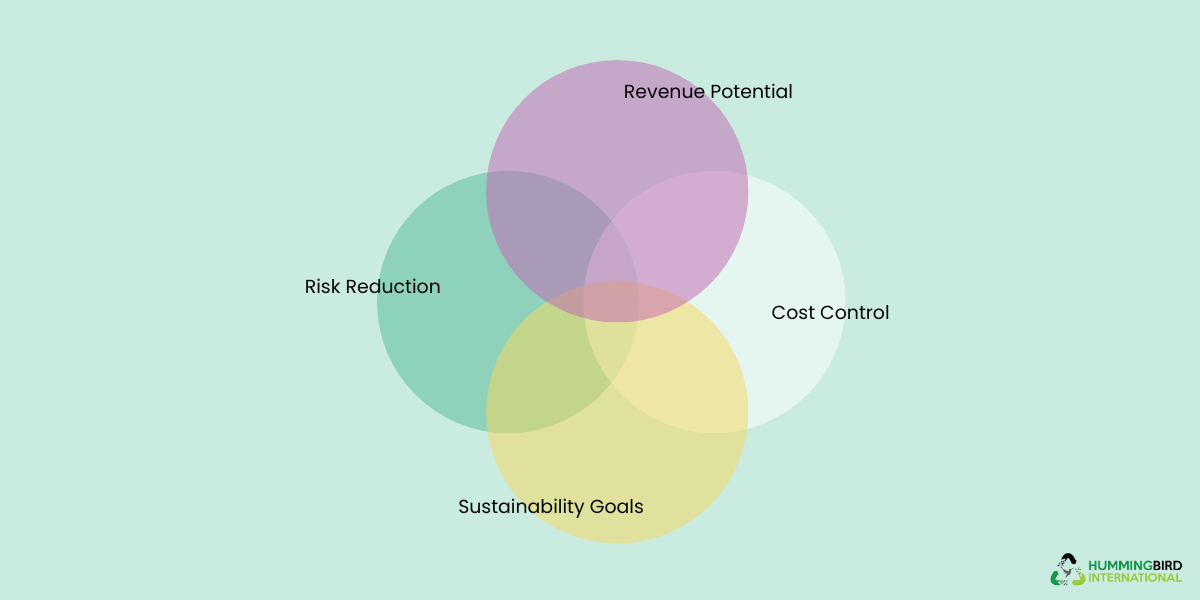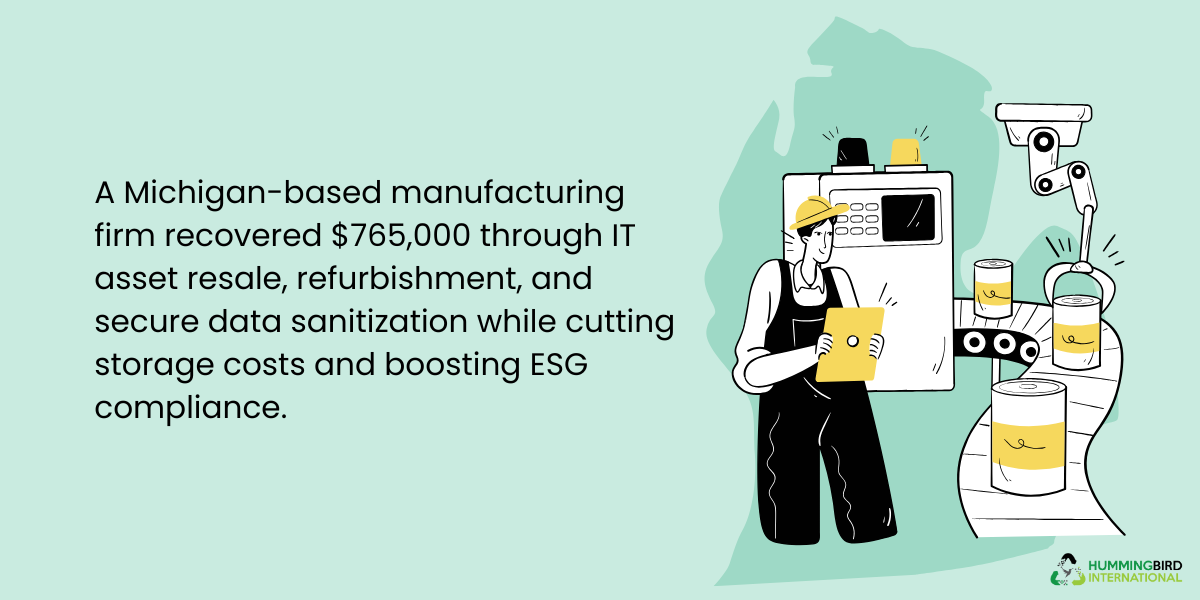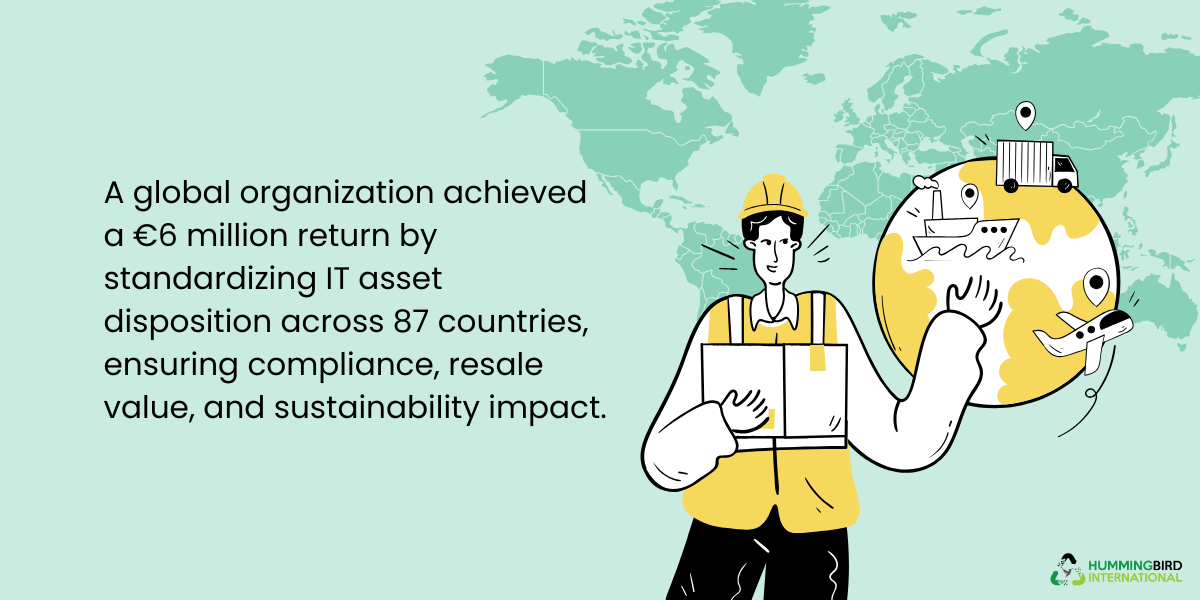Maximizing ROI Beyond Use: A CFO’s Guide to Monetizing Retired IT Assets

When you hear the phrase “retired IT assets,” your first thought might be dusty servers shoved in a backroom or laptops stacked in storage, waiting for someone to figure out what to do with them. For many companies, that’s exactly what happens: outdated equipment is pushed aside and quietly forgotten. But those “retired” assets aren’t worthless. In fact, they can be a surprisingly valuable source of revenue if handled correctly.
As a CFO, you’re constantly looking for ways to maximize returns, cut unnecessary costs, and stretch every dollar of company resources. What you may not realize is that your old IT hardware can actually help you do that. Whether it’s through resale, recycling, or redeployment, there are strategic ways to turn aging tech into measurable financial returns.
This guide breaks down how CFOs can uncover hidden value in retired IT assets while staying compliant, reducing risk, and boosting sustainability goals.
The Modern CFO’s Role: From Cost Control to Value Creation
Gone are the days when CFOs were simply the gatekeepers of company budgets, often known as the CF-No, who said “no” to anything that didn’t fit the numbers. Today’s finance leaders have stepped into a much broader role, becoming the CF-Know. This evolution from CF-No to CF-Know reflects a shift from blocking initiatives to enabling smarter, data-driven decisions that drive value across the business. With a deep understanding of operations, risk, technology, and strategy, modern CFOs are expected to drive innovation and find new revenue streams, not just cut costs.

Technology, ESG goals, and digital transformation all fall under their expanding influence. That’s exactly why managing retired IT assets has moved beyond being an operational afterthought to corporate responsibility. It’s a financial opportunity waiting to be tapped, and modern CFOs are in the best position to turn end-of-life hardware into measurable returns.
Why CFOs Should Care About Retired IT Assets?
When a laptop, server, or phone is phased out, it might feel like an IT problem. But in reality, it’s a finance problem too. Every retired asset sitting in a storeroom is tied-up capital that continues to lose value over time.

For CFOs, the decision is simple: let those assets depreciate into nothing, or find ways to recover value. Taking a proactive role here can free up cash, improve efficiency, and even strengthen compliance efforts.
Here’s what’s at stake:

- Revenue potential: Reselling or refurbishing usable hardware brings cash back to the business.
- Cost control: Proper e-waste recycling brings economic benefits, such as more jobs, resource recovery, and quick revenue.
- Risk reduction: Oversight ensures data security and compliance with regulations.
- Sustainability goals: Environmentally responsible asset management supports ESG initiatives.
By stepping in, CFOs make sure the company isn’t leaving money or opportunities on the table.
The Hidden Costs of Holding Onto Retired Assets
A few laptops tucked away in storage don’t look harmful, right? But the longer they sit, the more they quietly drain value from your business. Unused equipment takes up storage space, can still trigger maintenance or licensing costs, and, most importantly, poses serious data security risks if sensitive information isn’t properly wiped.

Then there’s compliance. Regulations like GDPR, HIPAA, and SOX don’t stop applying just because the hardware is out of circulation. Mishandling devices can lead to fines and reputational damage.
And let’s not forget the environmental impact of e-waste. Holding onto old IT assets instead of recycling them responsibly delays opportunities to reduce your organization’s footprint. Beyond the risks and costs, every idle device represents lost revenue that could have been recovered and reinvested back into the business. For CFOs, ignoring retired assets is an expensive oversight.
Core Monetization Strategies for Retired IT Assets
What looks like old, outdated hardware can actually become a new revenue stream if handled strategically. Instead of letting devices gather dust, CFOs can turn them into financial gains while also managing risks and advancing ESG goals.
1. Resale in Secondary Markets
Many retired IT assets still have resale value, especially laptops, servers, and networking equipment. With proper refurbishment, these devices can be sold through secondary markets, creating a new income stream. CFOs who partner with reliable ITAD vendors can ensure fair pricing, proper handling, and secure data erasure before resale.
Beyond cash recovery, resale also extends the equipment’s lifecycle, aligning with sustainability goals. It’s a straightforward way to turn depreciating assets into liquid funds that can be reinvested back into the business.
2. Internal Redeployment
Not every “retired” asset is truly obsolete. Often, devices phased out in one department can still serve another. Redeploying equipment internally saves money on purchasing new devices while making use of existing resources. This approach requires coordination between IT and finance to evaluate asset conditions, refurbish if necessary, and redirect them where they’re still useful.
While it may not generate direct revenue like resale, redeployment provides cost avoidance, which still enhances overall financial efficiency and keeps capital expenditures under control.
3. Recycling with Value Recovery
When resale or redeployment isn’t an option, responsible recycling is the next best path. Certified ITAD providers can recover valuable components such as precious metals, memory, and processors. These materials can be extracted and sold back into supply chains, creating a smaller but meaningful revenue stream.
Just as important, recycling helps companies avoid the environmental and reputational risks tied to improper disposal. For CFOs, value recovery through recycling ensures that even obsolete devices contribute something back—financially, operationally, and ethically.
4. Partnering with ITAD Vendors
Specialized IT Asset Disposition (ITAD) vendors offer structured programs to monetize assets while managing compliance and data security. These partnerships often use revenue-sharing models where both parties benefit from resale or recycling gains.
For CFOs, this means not only maximizing asset value but also transferring much of the operational burden to an expert partner. Working with certified ITAD vendors reduces risk, provides transparent reporting, and ensures that asset disposition aligns with both financial and ESG objectives.
5. Donations for Tax Benefits
Sometimes the financial return doesn’t come from resale or recycling but from smart tax planning. Donating retired IT assets to schools, nonprofits, or community organizations can generate valuable tax deductions while also strengthening corporate social responsibility efforts.
For CFOs, this option balances financial benefit with goodwill, allowing companies to showcase their commitment to community support and sustainability. While it may not deliver immediate cash flow, donations can enhance brand reputation, unlock tax savings, and ensure assets continue serving a useful purpose instead of ending up as waste.
CFO Action Checklist
Turning retired IT assets into financial gains requires more than good intentions—it takes structure. Here’s a step-by-step checklist CFOs can use to ensure no value is left behind.
• Audit Existing Retired Assets Across All Locations
Start by getting visibility into what you already have. Old laptops, servers, or networking gear often end up scattered across departments or storage rooms. A thorough audit helps you understand the volume, condition, and potential value of these assets. Without this baseline, it’s impossible to create a monetization strategy.
• Evaluate Certified ITAD Vendors for Partnership Opportunities
Not all ITAD providers are created equal. A certified ITAD vendor brings expertise in data security, compliance, and resale markets. Evaluate them based on certifications, transparency, and revenue-sharing models. A strong partner ensures maximum value recovery while minimizing risks.
• Establish Clear Monetization Policies and Compliance Processes
Set policies that define how assets should be handled when retired. This includes processes for data wiping, resale, recycling, and documentation. Clear policies not only streamline operations but also ensure compliance with laws like GDPR, HIPAA, and SOX.
• Track Financial Recovery and ESG Benefits in Regular Reporting
Monetizing IT assets isn’t just about quick cash. It’s also about proving long-term value. CFOs should track financial recovery, cost savings, and sustainability wins (like reduced e-waste) in regular reports. This demonstrates ROI while reinforcing the company’s ESG commitments.
Real-World Scenarios: Turning Retired Assets into Revenue
Sometimes the best way to see the impact of IT asset monetization is through real-world results. These examples highlight how organizations that took a structured approach to ITAD got significant financial and compliance benefits.
Michigan-Based Manufacturing Firm Recovers $765,000

A US manufacturing company partnered with an IT asset disposition provider to streamline its surplus equipment management. Through refurbishment, resale, and secure data sanitization, it recovered $765,000 in direct savings and value. The initiative also cut down on recurring storage and leasing costs while ensuring regulatory compliance. The CFO presented the results as both a financial win and an ESG achievement, reinforcing investor confidence.
Global Organization Secures €6 Million Return

A multinational company implemented a global ITAD program spanning 90,000 retired assets across 87 countries within 12 months. By standardizing collection, testing, secure data wiping, and resale processes, the organization achieved a net return of €6 million. Beyond financial gains, the program delivered consistent compliance and reduced the environmental impact of e-waste, reinforcing the CFO’s role as both a financial leader and sustainability driver.
The Modern CFO’s Next Move
Today’s CFOs are strategic leaders who shape the future, apart from being only the financial gatekeepers of the business. They need to keep pace with evolving responsibilities, from digital transformation to the environmental impact of e-waste. Retired IT assets are no longer just a back-office concern; they’re a real opportunity to enhance your rental ROI, strengthen compliance, and deliver measurable ESG results.
By partnering with a trusted IT asset disposition provider, CFOs can recover hidden value, safeguard data, and turn liabilities into financial gains, staying ahead in a role that demands both vision and adaptability.
About The Author Kelly Sampson
Kelly Sampson is a writer, blogger, and environmental enthusiast. She has strong opinions about climate change, the dogs vs. cats debate, and Oxford commas. She has lent Hummingbird International her engaging and spirited voice and turned our blog into a great place to find valuable information about e-waste, e-waste recycling, and the ITAD industry. Explore our blog to read more of her work.






